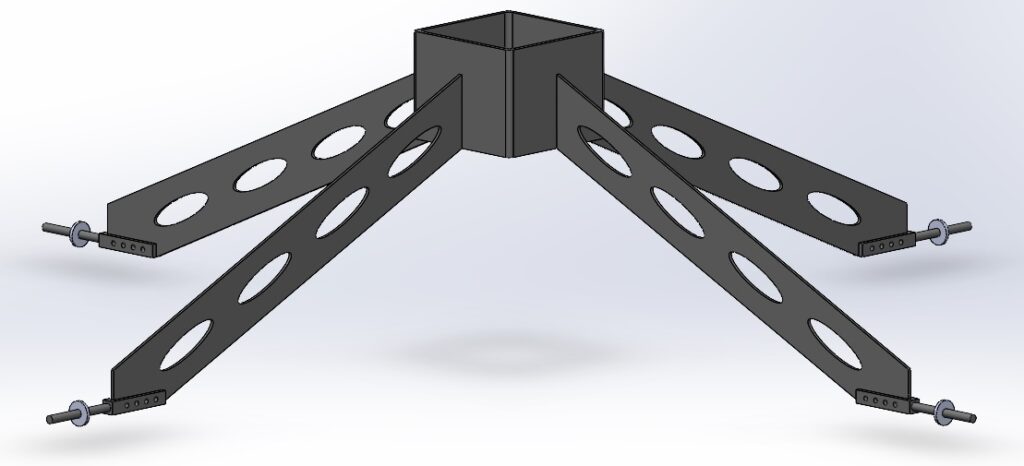Project Category: Multidisciplinary
Join our presentation
https://ucalgary.zoom.us/j/7999758951?pwd=ZFNTRW1vaGNtSE1rY1pROXJuR2h5dz09
Password: 738117
About our project
The Sandy Cross Telescope is the largest telescope at the Rothney Astrophysical Observatory, owned and operated by the University of Calgary. The telescope is currently used for teaching and public outreach events, however is not currently operational. Our goal is to change that.
The telescope’s configuration needs to be changed in order to get it back to working order. The previous configuration, called Cassegrain configuration, limited the field of view as well as the camera resolution. Our project involved changing this configuration to a prime focus, whereby we reduce the focal length. Prime focus configuration eliminates one mirror completely and places the instruments right at the focal point.
Our objective was to build a rigid structure that can hold all of the instruments above the telescope mirror without compromising the amount of light contacting the mirror itself, while ensuring the telescope remains in focus, at its now shorter focal point. Doing this allowed the telescope to increase the field of view by 5.7 times the precious amount.
https://www.youtube.com/watch?v=KhKZoI8Ot5w
Meet our team members


Anna Barrett
Harpreet Dhesa
Hassan Khan
Hunter Kalynchuk
Jacob Sola
Sumeet Sohal
Details about our design
HOW OUR DESIGN ADDRESSES PRACTICAL ISSUES
The main issue of the telescope is the limited focal length. Our new Prime Focus configuration solves this by changing the focal length ratio from a f/15 configuration to a f/2.6 configuration. This effectively increases the captured image of the sky by 5.7 times.
Inside the housing system at the top of our frame, where the camera device is used to capture the image from the telescope, we have installed a guide rail system such that all our equipment is mounted to a platform and can be raised or lowered using a motor controlled remotely. This ensures the telescope will always remain in-focus, and does not require any ladders or scaffolding to change or adjust the camera.
WHAT MAKES OUR DESIGN INNOVATIVE
Previously, the telescope worked by having light from the night sky come into the dome where it makes contact with our primary mirror, once it reflects off of the curved mirror the light gets focused onto the secondary mirror, then finally once again the focused light is reflected back towards the primary mirror where a small hole in the center of the mirror collects the focused light into various instruments. This is a relatively long distance for the light to travel. This is described by the f/15 focal ratio.
Our innovation is simple yet effective. Reducing the distance of the light traveled. By removing a second mirror, and by installing our own frame on top of the previously existing frame, the distance traveled changes the focal ratio to f/2.6. This was a basis of the lower focal length and the subsequent larger field of view.
WHAT MAKES OUR DESIGN SOLUTION EFFECTIVE
We built our very own structure that can hold the instruments exactly at the primary mirror’s focal point. In order for us to be precise we needed to build our structure to the specifications of the telescope. We also added adjustment features to the box component holding the instruments, to allow operations to make improvements to the focal point throughout the year. This was done by adding a platform that can move up and down inside the box with a motor, which can be controlled remotely. This also allows for thermal expansion adjustment; as the metal condenses in colder seasons, the platform can be moved upward to allow for the focal point to remain in the camera’s focus.
HOW WE VALIDATED OUR DESIGN SOLUTION
Our design needed to meet criteria set by our sponsor such as being rigid enough that when the telescope moves around in the dome it does not change the alignment of the instruments in the box. We accomplished this by cutting the legs of our structure out of ¼” steel sheet metal. This allowed us to maintain a rigid structure even when the telescope moves around and remains in focus of the primary mirror.
There was extensive analysis done to ensure the design met all the criteria given. Firstly, geometric analysis was needed to ensure the sizing was usable and did not interfere with the observatory dome. Finite Element Analysis was also used, along with several Solidworks modeling simulations to refine and optimize the size and weight of the rigid frame, all while remaining within our budget. Finally, numerous focal length dimension principles were applied and calculated to verify the practical ability to capture the new, shorter focal length.
FEASIBILITY OF OUR DESIGN SOLUTION
All structural parts used in our design were made and assembled in the University of Calgary maker space, we manufactured our own structure legs and instrument box as well as attaching the motor and guide rails in the box. This allowed us to control the dimensions of design and build it specifically for our telescope’s focal point. This also allowed for us to build the frame personally, and see our designs and hard work come to fruition.
Partners and mentors
Project Sponsor: Dr. Phil Langill
Project Technician: Jim Pake
This project was entirely in collaboration with Dr. Phil Langill and Jim Pake. Our team cannot thank them enough for their continued support and patience throughout the completion of this project. Please accept our utmost gratitude for working with us and making this project so very enjoyable.
Our photo gallery

Sandy Cross Telescope

proposed design

Final design
References
- RAO About”. Faculty Of Science, 2022, https://science.ucalgary.ca/rothney-observatory/about.
- “The Rothney Astrophysical Observatory Picture Gallery”. People.Ucalgary.Ca, 2022, https://people.ucalgary.ca/~milone/RAO.html.
